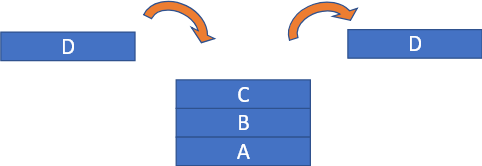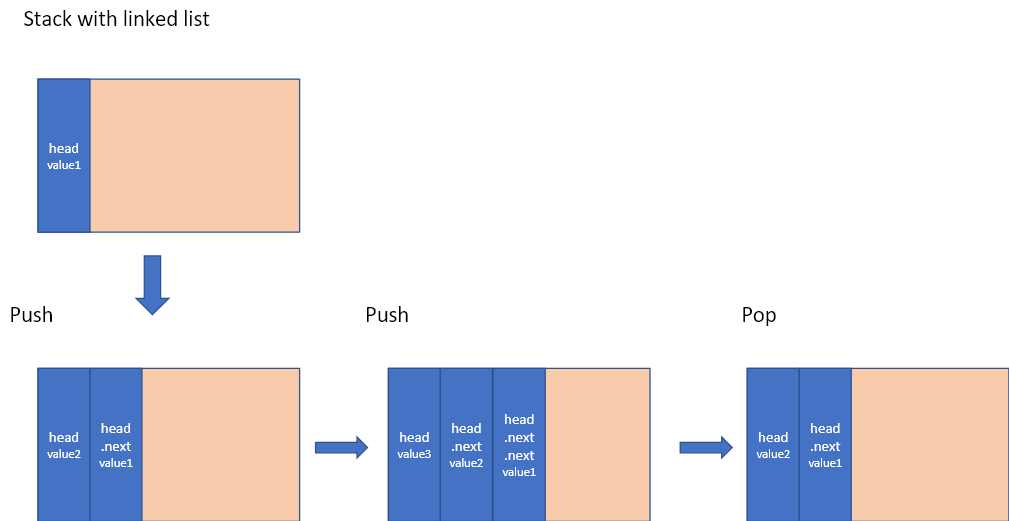Stack堆疊, 顧名思義其資料結構猶如堆疊般,最先放進去的資料最後才能取得(First-in last-out, FILO),最後放進去的資料,可以最先取得(Last-In First-Out manner, LIFO),這裡給大家展示用三種表現stack的方法,分別使用python list(without size limit)、python list(with size limit)和linked list (without size limit)。
python list (without size limit)
class Stack:
def __init__(self):
self.list=[]
def __str__(self):
values=[str(x) for x in self.list[::-1]]
return '\n'.join(values)
# isEmpty: 時間複雜度:O(1),空間複雜度:O(1)
def isEmpty(self):
if self.list==[]:
return True
else:
return False
# push: 時間複雜度:O(1),空間複雜度:O(1)
def push(self,value):
self.list.append(value)
return 'The element is successfully inserted'
# pop: 時間複雜度:O(1),空間複雜度:O(1)
def pop(self):
if self.isEmpty():
return 'There is no element in the stack'
else:
return self.list.pop()
# 最上層的資料: 時間複雜度:O(1),空間複雜度:O(1)
def peek(self):
if self.isEmpty():
return 'There is no element in the stack'
else:
return self.list[(len(self.list)-1)]
# 刪除整個stack: 時間複雜度:O(1),空間複雜度:O(1)
def delete(self):
self.list=None
mystack=Stack()
mystack.isEmpty()
>>True
mystack.push(5)
mystack.push(2)
mystack.push(3)
print(mystack)
>> 3
2
5
mystack.pop()
>> 3
print(mystack)
>> 2
5
mystack.peek()
>> 2
print(mystack)
>> 2
5
用python list (with size limited)製作stack
class stack:
# 時間複雜度: O(1), 空間複雜度:O(N)
def __init__(self,size):
self.list=[None]*size
self.maxsize=size
self.top=-1
# 時間複雜度: O(N), 空間複雜度:O(1)
def __str__(self):
values=[str(x) for x in self.list[::-1]]
return '\n'.join(values)
# 時間複雜度: O(1), 空間複雜度:O(1)
def isFull(self):
if self.top>=self.maxsize-1:
return True
else:
return False
# 時間複雜度: O(1), 空間複雜度:O(1)
def push(self,value):
if self.isFull():
return 'The stack is full.....'
else:
self.top+=1
self.list[self.top]=value
# 時間複雜度: O(1), 空間複雜度:O(1)
def pop(self):
if self.isEmpty():
return 'Your stack is empty'
else:
popped_value=self.list.pop(self.top)
self.top-=1
return popped_value
# 時間複雜度: O(1), 空間複雜度:O(1)
def peek(self):
if self.list==[]:
return 'Your stack is empty'
else:
return self.list[self.top]
# 時間複雜度: O(1), 空間複雜度:O(1)
def deleteall(self):
self.list=[]
return 'All the elements in the stack got successfully removed'
# 時間複雜度: O(1), 空間複雜度:O(1)
def isEmpty(self):
if self.top==-1:
return True
else:
return False
customStack=stack(4)
customStack.isEmpty()
>>True
customStack.push(1)
customStack.push(2)
customStack.push(3)
customStack.push(4)
print(customStack.isFull())
>>True
print(customStack)
>>4
3
2
1
customStack.peek()
>> 4
customStack.pop()
customStack.pop()
customStack.pop()
customStack.pop()
customStack.isEmpty()
>> True
用linked list做stack
linked list的部分,我感覺有圖可能比較好理解:
class Node:
def __init__(self,value=None):
self.value=value
self.next=None
class Stack:
# 時間複雜度: O(1), 空間複雜度:O(1)
def __init__(self):
self.head=None
# 時間複雜度: O(N), 空間複雜度:O(1)
def __str__(self):
temp_node=self.head
demo=''
while temp_node:
demo+=str(temp_node.value)
demo+='\n'
temp_node=temp_node.next
return demo
# 時間複雜度: O(1), 空間複雜度:O(1)
def isEmpty(self):
if self.head==None:
return True
else:
return False
# 時間複雜度: O(1), 空間複雜度:O(1)
def push(self,value):
new_node=Node(value)
if self.isEmpty():
self.head=new_node
else:
new_node.next=self.head
self.head=new_node
return 'Successfully push the value'
# 時間複雜度: O(1), 空間複雜度:O(1)
def pop(self):
if self.isEmpty():
return 'The stack is empty'
else:
popped_value=self.head.value
self.head=self.head.next
return popped_value
# 時間複雜度: O(1), 空間複雜度:O(1)
def delete(self):
self.head=None
exaStack=Stack()
exaStack.isEmpty()
exaStack.push(10)
exaStack.push(20)
exaStack.push(50)
exaStack.push(80)
exaStack.push(100)
print(exaStack)
>> 100
80
50
20
10
exaStack.pop()
>> 100
print(exaStack)
>> 80
50
20
10
參考資料:
本文主要為udemy課程: The Complete Data Structures and Algorithms Course in Python的學習筆記,有興趣的人可以自己上去看看。
